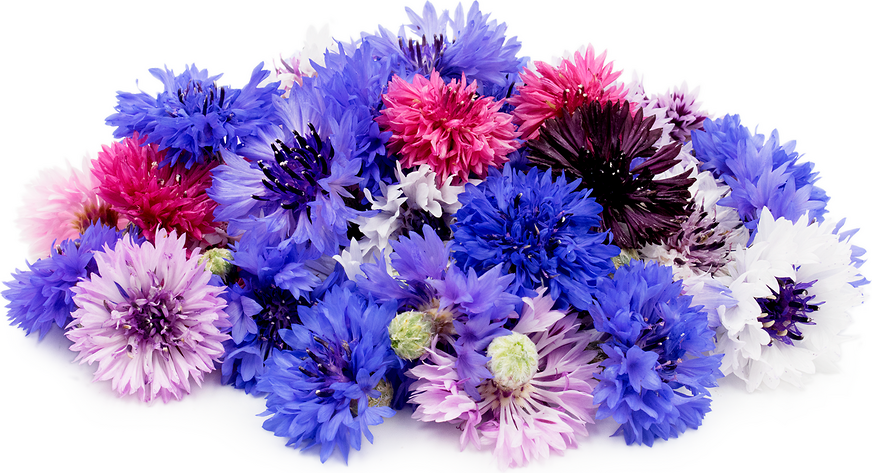


Bachelor's Button Flowers
Estimated Inventory, 50 ct : 22.00
This item was last sold on : 07/17/25
| Fresh Origins | Homepage |
Description/Taste
Bachelor’s Button flowers are small, showy blooms, averaging 2 to 5 centimeters in diameter, and have a spreading, upright appearance. The flowers grow on long, grey-green stems that can extend over one meter in height, and each flower is comprised of small, narrow, and jagged petals that cluster around a central disc. The flowers have a frilly, delicate appearance, and the petals are soft and crisp. Wild varieties of Bachelor’s Button flowers were primarily a cobalt blue, but with increased cultivation, the flowers now appear in shades of blue, purple, crimson, pink, and white. Bachelor’s Button flowers emit a faint aroma, and the petals are edible, containing a subtly vegetal, sweet, and peppery taste with cucumber and clove nuances.
Seasons/Availability
Bachelor’s Button flowers are available in the late spring through early fall.
Current Facts
Bachelor’s Button flowers, botanically classified as Centaurea cyanus, are an ancient wildflower belonging to the Asteraceae family. The brilliantly colored flowers are easy-to-grow annuals, first discovered in grasslands, pastures, fields, and meadows. Over time, the flowers were selected for commercial cultivation and were bred to showcase vibrant hues and unusual, jagged petals naturalized worldwide. Bachelor’s Button flowers are also hardy plants, sometimes acquiring the title of an invasive species in specific landscapes, but this hardiness has captured the favor of home gardeners who appreciate the plant’s resilience. The flowers are self-seeding and can grow in many types of soil, and there are several common names for the flowers used worldwide, with Cornflowers being the most prevalent. Bachelor’s Button flowers are also known as Boutonniere flower, Blue Bonnet, Blue Cap, Basket flower, Blue Bottle, Ragged Sailors, and Hurtsickle. The flowers earned their bachelor moniker from the Victorian Era. Single men would often wear a Cornflower in the buttonhole of their suit when they were courting women. The flower was a symbol of love and availability, and this practice eventually led the flowers to be a popular wedding boutonniere. Bachelor’s Button flowers have been used for centuries in culinary, medicinal, decorative, and practical applications. The flowers are preserved when dried, frequently used for everlasting flower arrangements, and the petals can be incorporated fresh or dried into culinary dishes, fabric dyes, and medicinal teas.
Nutritional Value
Bachelor’s Button flowers contain low amounts of vitamin C to reduce inflammation, folate to produce red blood cells, and calcium to protect bones and teeth. The flowers have also traditionally been used in natural medicines as an anti-inflammatory, steeped into teas and other mixtures. Bright blue Bachelor’s Button flowers get their vibrant hues from protocyanin, an anthocyanin pigment that contributes intense coloring to the petals. Protocyanin is what gives roses their rich red hues.
Applications
Bachelor's Button flowers are utilized fresh or dried as a vibrant, edible garnish in culinary preparations. The flowers can be placed whole on top of cakes, main dishes, or appetizers for visual impact, removed before consumption, or the petals can be separated and individually scattered over dishes. Bachelor’s Button flowers have a light fragrance and a subtle, peppery-sweet flavoring that complements green salads, stir-fries, or seafood dishes. The brightly colored petals can be scattered across charcuterie boards, pressed on top of dips and cheeses, layered into spring rolls, or incorporated into beverages and ice cubes as a decorative touch. The petals can also be sprinkled over custards, cakes, ice cream, and puddings or dried and mixed into tea blends. In addition to using the petals whole, Bachelor’s Button flowers can be used to naturally color sugar, icings, and syrups. Bachelor’s Button flowers pair well with vanilla, chocolate, caramel, fruits such as coconut, strawberries, blueberries, rhubarb, and apples, radishes, spring greens, broccoli, and meats including poultry, turkey, and fish. Freshly harvested Bachelor’s Button flowers will keep 1 to 2 weeks when stored in a glass of water with their stems intact. The petals can also be dried and stored in a sealed container for up to one year.
Ethnic/Cultural Info
Bachelor’s Button flowers were discovered in the tomb of King Tutankhamen, the famous Egyptian pharaoh who died in 1340 BC. The blossoms were woven into an intricate floral collar, a traditional accessory placed on the pharaoh’s body during the funeral. The floral collar was comprised of Bachelor’s Button flowers, olive leaves, berries, and other flowers, sewn onto papyrus, and a linen tie attached the collar. After the funeral, the floral collar was placed with other ceremonial items into large storage jars and was buried in the tomb with the belief that the pharaoh could use the items in the afterlife. Bachelor’s Button flowers are also historically tied to countries in Europe. The flowers are the national flower of Germany and were selected for their unique coloring, similar to Prussian blue, which was the color of the Prussian military uniform in the 17th and 18th centuries. Bachelor’s Button flowers were also significant in the famous Prussian story of Queen Louise. The legend states that the wildflowers concealed the queen and her children in a field during Napoleon’s invasion, and the kids remained quiet in the field by weaving the flowers into wreaths. After this story, Bachelor’s Button flowers became closely tied to Prussia, and the flowers have remained a symbol of hope, unity, and resilience in Germany.
Geography/History
Bachelor’s Button flowers are native to Europe and Western Asia and have been growing wild since ancient times. The flowers were spread in the Early Ages to Northern Africa, where they were extensively used in Ancient Egypt and were introduced to the British Isles sometime in the Iron Age. Bachelor’s Button flowers thrived in temperate regions and were once widely found in fields across Europe. Over time, herbicides and habitat destruction significantly reduced the wildflower’s prominence, eventually causing it to become endangered in some regions of Europe. Despite their decline in the wild, Bachelor’s Button flowers became a favored cultivated flower and were naturally bred to showcase multi-colored hues beyond the classic blue. Bachelor’s Button flowers were planted in the United States in the 1600s, and the fast-growing blooms quickly naturalized across the country, also becoming a favored home garden flower. In the 1930s and 1940s, many new varieties were created that are still sown in gardens today. Bachelor’s Button flowers are commonly found in corn and grain fields, grassy plains, along property borders, and in curated home gardens throughout Europe, Asia, Northern Africa, Canada, the United States, and Australia.
Featured Restaurants
Restaurants currently purchasing this product as an ingredient for their menu.
| Kettner Exchange Bar | San Diego CA | 909-915-9877 |
| Hotel La Jolla - Sea & Sky | La Jolla CA | 858-459-0261 |
| Black Radish | San Diego CA | 619-775-7412 |
| Nomade Tapas and Records | San Diego CA | 619-616-1670 |
| The Kitchen at MCASD | La Jolla CA | 619-880-8719 |
| Lafayette Hotel - Quixote | San Diego CA | 619-296-2101 |
| Javier Plascencia (Animalon) | Bonita CA | 619-295-3172 |
| Jeune Et Jolie | Carlsbad CA | 858-231-0862 |
| Solare Ristorante Lounge | San Diego CA | 619-270-9670 |
| Mission Bay Yacht Club | San Diego CA | 858-488-0501 |
| Part Time Lover | San Diego CA | 619-588-2411 |
| Polite Provisions | San Diego CA | 619-677-3784 |
| Wayfarer Bread | La Jolla CA | 805-709-0964 |
| Pendry SD (Pastry) | San Diego CA | 619-738-7000 |
| Rancho Valencia | Del Mar CA | 858-756-1123 |
| Hilton Garden Inn - Homewood Suites San Diego | San Diego CA | 619-696-6300 |
| Moxy San Diego Gaslamp | San Diego CA | 619-376-1850 |
| Kitchens for Good - Culinary Program | San Diego CA | 619-450-4040 |
| Bar Same Same (Bar) | Carlsbad CA | 760-470-9143 |
| Little Victory Wine Market | Carlsbad CA | 310-738-3380 |
| Portside Pier (TopSail) | San Diego CA | 858-268-1030 |
| Lafayette Hotel - The Gutter | San Diego CA | 619-296-2101 |
| Marriott Marina Kitchen | San Diego CA | 619-234-1500 |
| Tahona (Bar) | San Diego CA | 619-573-0289 |
| Poseidon on the Beach | Del Mar CA | 858-755-9345 |
| Vi At La Jolla Village | San Diego CA | 858-646-7700 |
| Fairmont Grand Del Mar | San Diego CA | 858-314-1975 |
| La Jolla Beach & Tennis Club | San Diego CA | 619-816-8319 |
| Solana Beach Kitchen | Solana Beach CA | 610-717-7217 |
| insideOUT (Bar) | San Diego CA | 619-793-9221 |
| Espadin | Temecula California | 951-383-5585 |
| Harvest Kitchen | Vista CA | 619-709-0938 |
| Tartine | Coronado CA | 619-435-4323 |
| The Holding Company | San Diego CA | 619-341-5898 |
| The Bower | Coronado CA | 949-212-3192 |
| Estancia Adobe | San Diego CA | 858-550-1000 |
| Camino Riviera Bar | San Diego CA | 619-685-3881 |
| Mission Pacific | Oceanside CA | 760-450-7864 |
| Lafayette Hotel - Mississippi Kitchen | San Diego CA | 619-296-2101 |
| OB Noodle House & Sake Bar | San Diego CA | 619-450-6868 |
Recipe Ideas
Recipes that include Bachelor's Button Flowers. One
| A Beautiful Mess |
|
Tips for Using Edible Flowers on Cake |
| Grown to Cook |
|
Edible Flower Canapes |




 Learn More...
Learn More...
